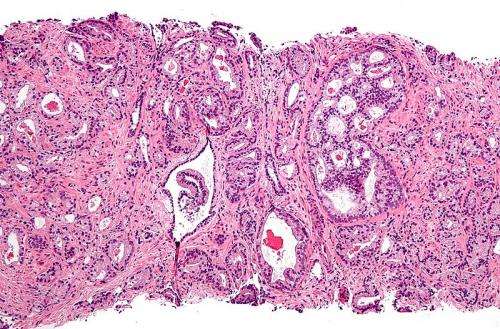Micrograph showing prostatic acinar adenocarcinoma (the most common form of prostate cancer) Credit: Wikipedia, CC BY-SA 3.0
An experimental urine test that detects genetic changes associated with prostate cancer identified 92 percent of men with elevated PSA (prostate-specific antigen) levels who had high-grade cancers, according to a study published today in JAMA Oncology online.
"The test has the potential to be a significant improvement over PSA alone in distinguishing between low- and high-grade prostate cancer, especially in the PSA gray zone patient. It could reduce hundreds of thousands of invasive biopsies each year. Given the pain and risks associated with performing a prostate biopsy, that's not a trivial thing," said first author James McKiernan, MD, the John K. Lattimer Professor and chair of urology at Columbia University Medical Center (CUMC). In addition the test is the only urine-based assay that does not require a digital rectal exam prior to collection and is easily integrated in the clinic environment.
Although the PSA blood test is commonly used to screen for prostate cancer, its value has come under question. An elevated PSA level—above 4 ng/mL—only indicates that a patient may have cancer and does not reliably distinguish between low-grade cancer, which can be monitored without active treatment, and high-grade disease, which requires aggressive treatment with surgery or radiation therapy. And because PSA tests yield a high number of false positive results—only 25 percent of men with an elevated PSA level have prostate cancer—the US Preventive Services Task Force recommends against PSA-based screening.
The only way to definitively diagnose prostate cancer is with a tissue biopsy, a painful procedure that carries a substantial risk of bleeding and infection and a very small chance of death.
"Consequently, men with high PSA levels are typically advised to have a biopsy, even though most have no cancer at all, or have a type of disease that can be monitored without treatment," said Dr. McKiernan. "In other words, a lot of men are undergoing unnecessary biopsies."
In the study, prostate biopsy results from 774 men with PSA levels between 2 and 10 were compared with a composite score based on results of the urine test plus other risk factors, including PSA level, age, race, and family history of the disease.
Using data from 255 of the men, the researchers first set a cut-off score of 15.6 that identified over 90 percent of men found to have high-grade cancer. The researchers then assessed the test's performance among the remaining 519 men using the designated cut-off score. A score above 15.6 was used to predict the presence of high-grade cancer (Gleason Score greater or equal to 7); a score equal to or below 15.6 was used to predict the presence of low-grade cancer or no disease.
This analysis showed that the test correctly identified 92 percent of men with high-grade cancer. However, the test also predicted high-grade cancer in 66 percent of men whose biopsies revealed low-grade or no cancer. In clinical practice, use of the test would have spared 27 percent of men from having an unnecessary prostate biopsy.
Among the 138 men who received a low test score, predicting low-grade or no cancer, 91 percent had no cancer or low-grade cancer that didn't require immediate treatment. "By adding this test to our evaluation, men who receive a low score could potentially choose to forgo a biopsy," Dr. McKiernan says.
Of the 12 men who had high-grade cancer but received a low test score, nine had moderately aggressive cancer that would likely have been detected with follow-up monitoring. The remaining three had a higher risk of cancer.
The test, called ExoDxTM Prostate(IntelliScore), detects RNA from three genes (ERG, PCA3, and SPDEF) that have been linked to the development and progression of prostate cancer. The RNA is encapsulated in lipid membrane-coated structures called exosomes that are excreted by cancer cells into urine. The test, developed by Exosome Diagnostics of Cambridge, MA, is the first urine-based test for prostate cancer that does not require a digital rectal exam or prostate massage before sample collection. Additional clinical trials to obtain FDA approval are being planned.
Based on the current study, the test's AUROC score, which is a measure of how well the test plus PSA and risk factors distinguishes men with high-grade disease from men without, was superior to that of the current standard of care, at 0.72 versus 0.63. (A test with an AUROC score of 1.0 is perfect; a test that performs no better than random guessing has a score of 0.5.)
Prostate cancer is the most common solid malignancy and the second leading cause of cancer death in men worldwide, with over a million new cases and approximately 300,000 deaths in 2014, according to the researchers. Approximately two million transrectal ultrasound-guided prostate biopsies are performed each year in the US and Europe.
More information: JAMA Oncology, dx.doi.org/10.1001/jamaoncol.2016.0097
Journal information: JAMA Oncology
Provided by Columbia University Medical Center






















